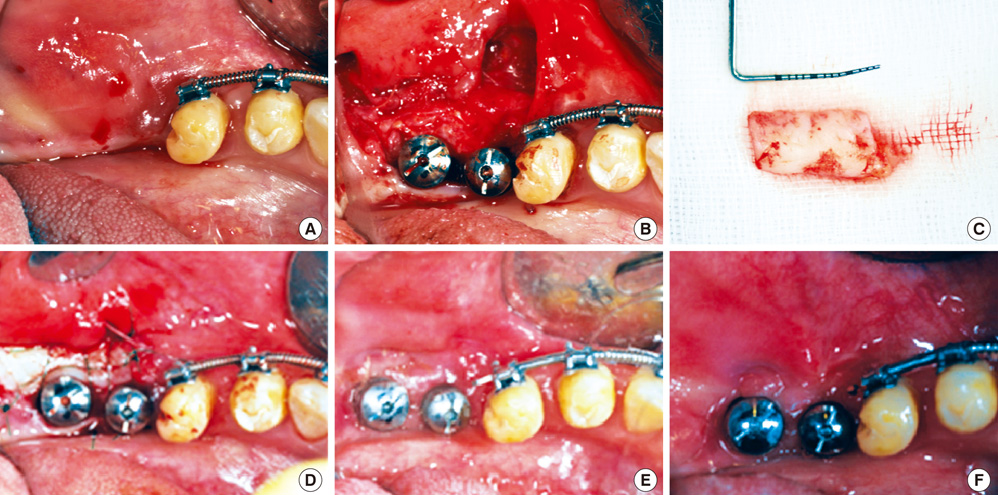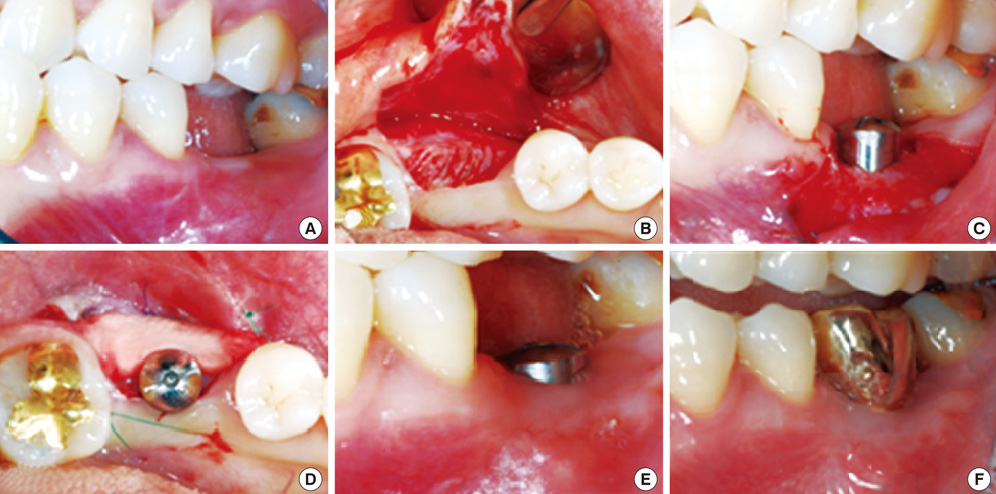J Periodontal Implant Sci.
2010 Apr;40(2):96-101. 10.5051/jpis.2010.40.2.96.
Clinical evaluation of a collagen matrix to enhance the width of keratinized gingiva around dental implants
- Affiliations
-
- 1Department of Periodontology, Chosun University School of Dentistry, Gwangju, Korea. periojang@chosun.ac.kr
- KMID: 1783541
- DOI: http://doi.org/10.5051/jpis.2010.40.2.96
Abstract
- PURPOSE
The purpose of this study was to evaluate the effect of collagen matrix with apically positioned flap (APF) on the width of keratinized gingiva, comparing to the results of APF only and APF combined with free gingival graft (FGG) at the second implant surgery.
METHODS
Nine patients were selected from those who had received treatments at the Department of Periodontics, Chosun University Dental Hospital, Gwangju, Korea. We performed APF, APF combined with FGG, and APF combined with collagen matrix coverage respectively. Clinical evaluation of keratinized gingival was performed by measuring the distance from the gingival crest to the mucogingival junction at the mid-buccal point, using a periodontal probe before and after the surgery.
RESULTS
The ratio of an increase was 0.3, 0.6, and 0.6 for the three subjects in the APF cases, 3, 5, and 7 for the three in the APF combined with FGG case, and 1.5, 0.5, and 3 for the three in the APF combined with collagen matrix coverage case.
CONCLUSIONS
This study suggests that the collagen matrix when used as a soft tissue substitute with the aim of increasing the width of keratinized tissue or mucosa, was as effective and predictable as the FGG.
Keyword
MeSH Terms
Figure
Cited by 2 articles
-
Simultaneous placement of an interpositional free gingival graft with nonsubmerged implant placement
Joo-Yeon Sohn, Jung-Chul Park, Kyoo-Sung Cho, Chang-Sung Kim
J Periodontal Implant Sci. 2014;44(2):94-99. doi: 10.5051/jpis.2014.44.2.94.Preservation of keratinized mucosa around implants using a prefabricated implant-retained stent: a case-control study
Chang-Soon Kim, Hieu Pham Duong, Jung-Chul Park, Hyun-Seung Shin
J Periodontal Implant Sci. 2016;46(5):329-336. doi: 10.5051/jpis.2016.46.5.329.
Reference
-
1. Wennstrom JL, Bengazi F, Lekholm U. The influence of the masticatory mucosa on the peri-implant soft tissue condition. Clin Oral Implants Res. 1994. 5:1–8.
Article2. Bengazi F, Wennstrom JL, Lekholm U. Recession of the soft tissue margin at oral implants. A 2-year longitudinal prospective study. Clin Oral Implants Res. 1996. 7:303–310.
Article3. Albrektsson T, Zarb G, Worthington P, Eriksson AR. The long-term efficacy of currently used dental implants: a review and proposed criteria of success. Int J Oral Maxillofac Implants. 1986. 1:11–25.4. Lang NP, Loe H. The relationship between the width of keratinized gingiva and gingival health. J Periodontol. 1972. 43:623–627.
Article5. Langer B, Sullivan DY. Osseointegration: its impact on the interrelationship of periodontics and restorative dentistry: Part I. Int J Periodontics Restorative Dent. 1989. 9:84–105.6. Wei PC, Laurell L, Geivelis M, Lingen MW, Maddalozzo D. Acellular dermal matrix allografts to achieve increased attached gingiva. Part 1. A clinical study. J Periodontol. 2000. 71:1297–1305.
Article7. Simion M. Soft tissue healing on application of a natural collagen matrix. 2009. In : 6th Congress of the European Federation of Periodontology; June 4-6; Stockholm, Sweden.8. Sanz M, Lorenzo R, Aranda JJ, Martin C, Orsini M. Clinical evaluation of a new collagen matrix (Mucograft prototype) to enhance the width of keratinized tissue in patients with fixed prosthetic restorations: a randomized prospective clinical trial. J Clin Periodontol. 2009. 36:868–876.
Article9. Luitaud C, Laflamme C, Semlali A, Saidi S, Grenier G, Zakrzewski A, et al. Development of an engineering autologous palatal mucosa-like tissue for potential clinical applications. J Biomed Mater Res B Appl Biomater. 2007. 83:554–561.
Article10. Barone R, Clauser C, Grassi R, Merli M, Prato GP. A protocol for maintaining or increasing the width of masticatory mucosa around submerged implants: a 1-year prospective study on 53 patients. Int J Periodontics Restorative Dent. 1998. 18:377–387.11. Prato GP, Clauser C, Cortellini P. Periodontal plastic and mucogingival surgery. Periodontol 2000. 1995. 9:90–105.
Article12. Dorfman HS, Kennedy JE, Bird WC. Longitudinal evaluation of free autogenous gingival grafts. J Clin Periodontol. 1980. 7:316–324.
Article13. Wennstrom J, Lindhe J, Nyman S. Role of keratinized gingiva for gingival health. Clinical and histologic study of normal and regenerated gingival tissue in dogs. J Clin Periodontol. 1981. 8:311–328.
Article14. Wennstrom J, Lindhe J. Role of attached gingiva for maintenance of periodontal health. Healing following excisional and grafting procedures in dogs. J Clin Periodontol. 1983. 10:206–221.
Article15. Kennedy JE, Bird WC, Palcanis KG, Dorfman HS. A longitudinal evaluation of varying widths of attached gingiva. J Clin Periodontol. 1985. 12:667–675.
Article16. Langer B, Langer L. Subepithelial connective tissue graft technique for root coverage. J Periodontol. 1985. 56:715–720.
Article17. Bohannan HM. Studies in the alteration of vestibular depth I. Complete denudation. J Periodontol. 1962. 33:120–127.
Article18. Egli U, Vollmer WH, Rateitschak KH. Follow-up studies of free gingival grafts. J Clin Periodontol. 1975. 2:98–104.
Article19. Han TJ, Takei HH, Carranza FA. The strip gingival autograft technique. Int J Periodontics Restorative Dent. 1993. 13:180–187.20. Park JB. Increasing the width of keratinized mucosa around endosseous implant using acellular dermal matrix allograft. Implant Dent. 2006. 15:275–281.
Article21. Yan JJ, Tsai AY, Wong MY, Hou LT. Comparison of acellular dermal graft and palatal autograft in the reconstruction of keratinized gingiva around dental implants: a case report. Int J Periodontics Restorative Dent. 2006. 26:287–292.22. Imberman M. Gingival augmentation with an acellular dermal matrix revisited: surgical technique for gingival grafting. Pract Proced Aesthet Dent. 2007. 19:123–128.23. Hammerle CH, Jung RE, Feloutzis A. A systematic review of the survival of implants in bone sites augmented with barrier membranes (guided bone regeneration) in partially edentulous patients. J Clin Periodontol. 2002. 29:Suppl 3. 226–231.
Article
- Full Text Links
- Actions
-
Cited
- CITED
-
- Close
- Share
- Similar articles
-
- Free Gingival Graft to Gain Peri-implant Keratinized Mucosa
- The effect of dental protrusion on the width of attached gingiva
- Regeneration of total tissue using alveolar ridge augmentation with soft tissue substitute on periodontally compromised extraction sites: case report
- Preservation of keratinized mucosa around implants using a prefabricated implant-retained stent: a case-control study
- A simple approach to preserve keratinized mucosa around implants using a pre-fabricated implant-retained stent: a report of two cases




